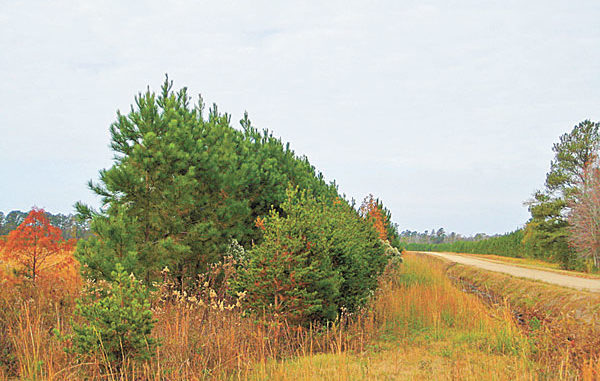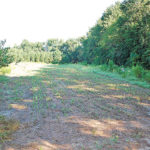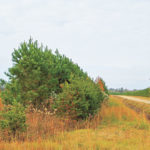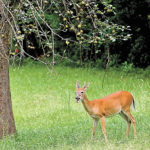
The southeastern states offer deer hunters an extended period to pursue their trophies. With the hunting season spanning the entire mating ritual, consistent disturbance becomes a real issue for deer and hunters.
Hunters can quickly improve their chances of encountering a trophy buck with a little buffering and protection from unnatural disturbances in highly attractive sites on your property. Winter offers hunters ideal conditions to begin beefing up buffers around agriculture fields and food plots often exposed to unnatural disturbances.
Deer in the Carolinas thrive on the abundant resources available. Even though suburbia continues to creep into rural areas, the precious resources these deer demand remain available. The majority of the deer-rich wilderness in North Carolina and South Carolina offers deer escape cover near their prime, natural food sources. Deer can feed within the protection of the forest when these foods are available, but that doesn’t stop a regional migration to a newly-planted agriculture crop or collaboration of lush food plots created by an conscientious hunter.
The thousands of acres of commercial agriculture and private food plots will draw deer in from miles around to take advantage of these readily-available food sources. They offers deer with an enormous food source and prime setting for deer stands.
To the hunter’s disadvantage, deer do not limit their travels to the daylight hours, like the eastern wild turkey does. Otherwise, reaching the daily or season limit would significantly impact the overall deer population in no time at all.
The long season wears heavily on deer. They will feed at any time of day, and pressured deer will focus their major feeding intervals after nightfall. Large, mature bucks learn to evade dangerous situations and rarely will be caught during daylight hours in an exposed agriculture field or food plot. Care should be taken to shield these areas from unnecessary disturbances, which will promote use during any time of day. Protection is needed to keep these deer comfortable while they are frequenting these rich feeding areas.
Often, many agriculture fields are located along highways, and many food plots are created from existing agriculture fields. While deer may become adapted to the constant moving traffic, a traveling motorist will frequently pull off to take a peek, quickly flushing the deer back into the forest cover.
Even when food plots are miles away from a public highway, they will frequently be created adjacent to a heavily-traveled woods road, which usually lacks significant cover to shield grazing wildlife from curious onlookers passing by.
Protection is the key to keep deer on food sources during daylight hours. Planting forested buffers along any and all travel corridors will significantly-improve the productivity of food plots and prime agriculture fields during the hunting season.
The width of these buffers should be directly correlated to the level of disturbance expected along the travel corridor. Highly traveled roadways need wider buffer strips than a small dirt road bordering a food plot deep in a forested hunting tract. At a minimum, the buffers should be no less than 25 feet wide, but 75 to 125 feet is ideal and preferred to fully protect these animals from unnatural disturbances.
The best buffers have a combination of tree, shrub, and brushy materials. The intent of any buffer is to provide 100-percent visual blockage and as much sound protection as possible.
The preferred way to establish these buffers is from a combination of planting and volunteer recruitment. Unfortunately, buffer establishment can be a lengthy process. Tree plantings should be the start of these buffers, with volunteer shrub and brushy species following afterwards. Pines and other evergreen species susceptible to rapid growth should be selected to jump-start these buffers. Selecting evergreen trees also prevents any period of leaf fall compromising the buffer’s integrity as well. And soils across a majority of the Carolinas are very conducive for growing pine trees.
On most sites, loblolly pine is the choice for rapid height growth in just a few years time. On sites that feature particularly dry conditions, longleaf pines should replace loblolly plantings for a higher survival rate. Planting a combination of loblolly and shortleaf or Virginia pine will accelerate the coverage of several strata from manual plantings. While loblolly is known for growing tall quickly, the shortleaf and Virginia pine will have more lateral growth to cover the lower stratum.
Loblolly pines should be planted at a minimum of three to five rows deep. Trees should be spaced six to eight feet apart along rows, and rows should be 10 feet apart. This spacing represents approximately 600 to 700 trees per acre. Shortleaf or Virginia pine should be planted along the roadway or in the interior of the buffer in their own rows, but in voids of the loblolly pine to complete buffer coverage. As the trees grow, other volunteer species will invade these areas contributing to the protective buffer. In addition to planting trees, shrub species such as wax myrtle can be planted to jump-start the lower stratum as well.
While buffers can be created any time of year, all plantings in these buffers should be confined to the December-through-March period.
In an effort to further encourage growth of these buffers, seasonal fertilization can be helpful. A balanced fertilizer of equal parts phosphate, nitrogen and potash can be broadcasted over the buffers in the spring and throughout the summer.







Be the first to comment